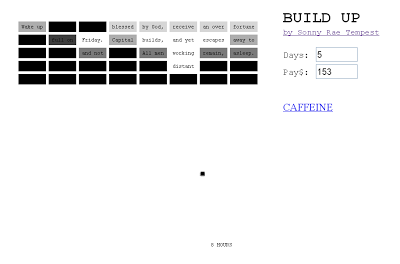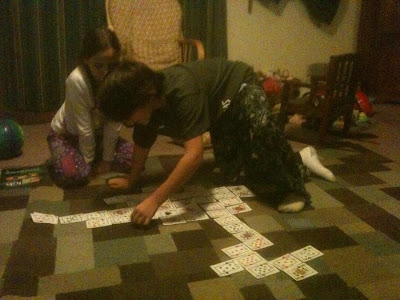 |
| Gap - A Navigable Poem - A Screenshot |
Gap is a navigable poem that explores American masculinity.
What defines a "man" in America? Clothes? Job description? Dominance, through physical force or weaponry? Culturally acceptable addictions (eg. beer, coffee, gambling, porn)? From where are we choosing to learn about masculinity? From our parents? From our churches? From TV? Who gets to tell us what makes an acceptable/ideal man?
Gap explores these issues via navigable text. Within the poem, the reader controls a letter "A," a supposed Alpha male, a boat that can navigate the waters filling the gap between what is and what is not a man. This water gap through which the reader navigates is represented by an intentional text river, white space that is typically re-aligned in text to aid in readability, that runs between two mountains of words that comprise the poem. By sailing through this text river, the reader's "A" completes words and phrases as the poem is read from bottom to the top.
When discovering what defines manhood, not everything is clear. The world of the poem is dark, unknown, and the reader's torch illuminates a limited view of the entire text. In fact, the reader will never be able to discover every word written. No one male knows everything it takes to be a "Man."
As gender gaps slowly close in America, it is hard for a man to know his place concretely. While socially men may be (at least at some point) equal to women, naturally and biologically we are markedly different, and that's okay. Women amaze me at their ability to celebrate their womanhood.
Men scare me.
To read this poem:
- download the entire .zip file from here: Gap.zip
- Open the file Gap.exe.
- Control the "A" boat with the arrow keys (up, left, right; there is no going back).
At this point, this poem is only for Windows. It was written in .python and therefore I'll technically be able to create linux and (ugh) Mac versions; I just haven't yet.
Enjoy!
SRT
What defines a "man" in America? Clothes? Job description? Dominance, through physical force or weaponry? Culturally acceptable addictions (eg. beer, coffee, gambling, porn)? From where are we choosing to learn about masculinity? From our parents? From our churches? From TV? Who gets to tell us what makes an acceptable/ideal man?
Gap explores these issues via navigable text. Within the poem, the reader controls a letter "A," a supposed Alpha male, a boat that can navigate the waters filling the gap between what is and what is not a man. This water gap through which the reader navigates is represented by an intentional text river, white space that is typically re-aligned in text to aid in readability, that runs between two mountains of words that comprise the poem. By sailing through this text river, the reader's "A" completes words and phrases as the poem is read from bottom to the top.
When discovering what defines manhood, not everything is clear. The world of the poem is dark, unknown, and the reader's torch illuminates a limited view of the entire text. In fact, the reader will never be able to discover every word written. No one male knows everything it takes to be a "Man."
As gender gaps slowly close in America, it is hard for a man to know his place concretely. While socially men may be (at least at some point) equal to women, naturally and biologically we are markedly different, and that's okay. Women amaze me at their ability to celebrate their womanhood.
Men scare me.
To read this poem:
- download the entire .zip file from here: Gap.zip
- Open the file Gap.exe.
- Control the "A" boat with the arrow keys (up, left, right; there is no going back).
At this point, this poem is only for Windows. It was written in .python and therefore I'll technically be able to create linux and (ugh) Mac versions; I just haven't yet.
Enjoy!
SRT




























